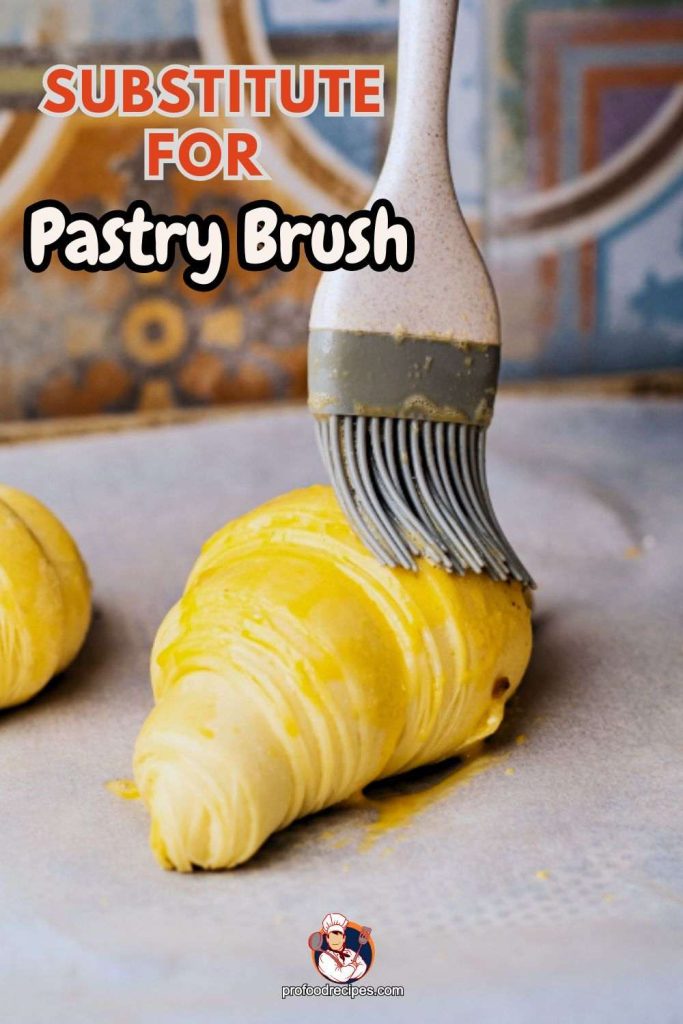Last Updated on September 20, 2023 by Amanda P. Brown
An unused paintbrush can be used in the absence of a pastry brush. Additionally, coffee filters, unused toothbrushes, paper towels, parchment paper, or leafy greens can be used as a substitute for pastry brush.
Whether you apply egg wash, butter, or other liquids to your pastries and baked items, these alternatives can help you get the same results. These alternatives can enable you to make delectable delicacies without pausing, whether in a pinch or just curious to try something new.
However, you can read the following article for more information on each substitute for a pastry brush.

10 Substitute for Pastry Brush
Table of Contents

A pastry brush is a simple cooking tool for applying oil, butter, sauce, and more. It’s a must-have for any pastry chef serious about producing show-stopping glazed treats.
But, probably, you don’t always have a pastry brush on hand. Nonetheless, substitutes for pastry brush exists. If you’re wondering What Can I Use Instead Of A Pastry Brush- the best alternatives are listed below.
1. Parchment Paper
Parchment paper, made of thin wax-treated paper, makes cleanup after baking a breeze. Also, since parchment paper is nonstick, it may be used to knead dough without additional flour.
- Prepare a large strip of parchment between 10 and 12 inches in length.
- Make a rectangle with the paper and then another smaller rectangle by folding it in half.
- Cut vertical strips with scissors along the unfolded, shorter side of the rectangle to use as bristles.
2. Paint Brush- Unused
A paintbrush is a versatile instrument rarely given the credit it deserves. It’s remarkable how much potential lies dormant in a paintbrush. In the kitchen, it is indispensable.
You can use this inexpensive tool instead of pricey pastry brushes for everything from marinating meat to greasing cookware.
- Pick a paintbrush about the same size as a flat pastry brush. Usually, a medium-sized brush with soft bristles would do the trick.
- Spread the liquid with a brush on the pastry.
- Paintbrush bristles are often tougher than pastry bristles, so use caution when applying pressure.
3. Coffee Filters
When making coffee in a percolator or a drip coffee machine, the grounds are filtered through a paper-like substance known as a coffee filter. However, if you need a pastry brush in a pinch, a coffee filter has a pleasant enough texture to do the job.
Using a coffee filter has various benefits, including eliminating wasteful handling, purification of the grounds and oils that may be used to create unique tastes, and elimination any resulting mess.
- Simply bundle the filter at the bottom, soak the edges well in your brushing liquid, and begin brushing.
- If the coffee filter is too big to use as a toothbrush, try cutting it in half or folding it in thirds.
4. Paper Towel
Paper towels are a convenient and inexpensive option that frequently comes in pre-cut sizes. You can use them to swiftly dry your hands and dishes, wipe up spills, and clean up messes.
As a bonus, they can be used instead of pastry brushes by dipping them in melted butter or oil before applying the glaze to baked goods.
- Roll up the paper towel and wet the corner, touching the bottom with your basting liquid.
- Use as required to gently rub over your food.
- If you don’t have any thinner napkins, thick ones will suffice in a pinch; just be careful not to get any paper scraps in your meal.
5. Silicone Brushes
A silicone brush can be used in place of a traditional pastry brush since it is more practical and easier to clean. Liquids may be applied on pastries with greater ease and precision with this tool. Because they can be cleaned and reused often, silicone brushes are a handy addition to any kitchen.
- Pick a silicone brush whose diameter is the same as the pastry brush or the amount of liquid you’ll use.
- The silicone paintbrush may be used directly from the liquid.
- Brush bristles should be completely submerged in liquid, but don’t fill the container to the brim. Use a gently patting or brushing motion to distribute it evenly.
6. A Spoon + Paper Towel
You won’t be able to achieve pinpoint accuracy with this approach, but it will do the trick.
- To apply the brushing liquid, just pour it over the pastry with a spoon and then spread it out with a paper towel that has been gently wadded.
- You can get more consistent results by briefly dipping the paper towel into the brushing liquid at intervals.
7. An Unused Toothbrush
There are numerous other things you can do with a toothbrush than brushing your teeth. Brushing pastry dough with butter or egg wash, for example, requires a soft, sweeping motion, and this brush’s bristles are ideal for the job.
As it’s the same size as a standard pastry brush, there’s no need to stock up on various shaped and sized kitchen brushes.
- If the bristles on your toothbrush are too long or hard to use as a pastry brush, you may easily shorten them.
- Carefully apply the liquid to the pastry by brushing it on in a circular motion. Spread it on evenly with a light patting or brushing motion.
- The major problem with this alternative is that a toothbrush’s bristles (particularly those of a brand-new toothbrush) will be much stiffer than what is optimum and noticeably shorter. You can get by, though; just be careful while spreading on the butter, egg, etc.
8. A Freezer Bag
A freezer bag can do the trick if you don’t have a pastry brush on hand but still require precise control over applying liquids. By adjusting the size of the incision in the bag’s corner, you may control the liquid flow rate and the stream’s consistency.
- Use a fresh, sterile, airtight freezer bag. Pour the liquid into the freezer bag, but don’t saturate it. Overfilling the container is not recommended.
- Before you seal the freezer bag, make sure it is completely airtight. Using scissors, clip off one of the bag’s sealed corners to remove it.
- To adjust the consistency of the liquid stream, make a small incision and go larger if necessary.
- Hold the sealed freezer bag with the cut corner facing down. Squeeze it gently to get a continuous trickle of liquid out of the bag.
- Brush or pat the liquid onto the pastry gently. Squeezing the bag as often as necessary will provide a uniform coating. The pace of liquid discharge may be controlled by adjusting the pressure within the bag.
9. Leafy Greens
Lettuce, celery, and sprigs of other herbs can be used as a substitute for a pastry brush. Also, when basting meats or vegetables with marinades, sauces, or oils, use a basting brush made of a leafy green vegetable. You can use fresh herbs from the garden as a basting sauce for grilled meat.
- Pick greens with big, shiny leaves that won’t wilt easily. The leaves must be clean.
- To apply the liquid, dip the greens brush into it. Make sure it can soak up a sufficient amount of fluids.
- Apply the pastry’s liquid by brushing it with the leafy leaves. Like when using a pastry brush, a little patting or brushing motion will do the trick.
Read More:
10. Use Your Fingers
Without a proper pastry brush, your fingertips can be a suitable alternative. The surface of the pastry may be handled and felt with complete precision and control.
- The first step is to wash your hands thoroughly with soap and water. Squeeze as much of the liquid from the bottle as you can with your fingertips and then apply it.
- Spread the liquid over the pastry with your fingertips. Spread the product out using a circular patting or brushing motion.
- Use caution since mishandling might result in shattered pastries.
FAQs
What Are the 2 Types of Pastry Brush?
Round-headed brushes and Angled brushes. For intricate glazing projects or plating decorating, a round-headed brush is ideal. The pointed bristles of an angled brush make it ideal for reaching deep into an oven or grill, where a sauce or glaze may be applied with pinpoint accuracy.
Is a Pastry Brush Just a Paint Brush?
N0. A pastry brush, often called a basting brush, is used in the kitchen for applying sauces, butter, and other condiments to meals. Unlike their silicone bristled counterparts, traditional pastry brushes are formed of natural bristles or a plastic or nylon fiber comparable to a paint brush.
What is a Bakers Brush?
A baker’s birch and horse hair brush may be used to clean the counter, remove extra flour from the bread, and distribute the flour uniformly across the baking board. Horsehair can be put in the oven since it can withstand high temperatures. Included a set that also included a pastry brush and a dough scraper.
What Are Natural Pastry Brushes Made of?
Natural (often boar’s-hair) and synthetic options are the most popular. A few other synthetic bristles are on the market, but silicone is the most ubiquitous and widely used. Five of the best-selling pastry brushes on Amazon are constructed entirely of silicone.
Can I Brush Pastry With Egg?
Yes. Pastries brushed with an egg wash become shiny and have a pleasing golden hue. The second role is adhesiveness. The sugar and the crust in this Pop Tart recipe benefit from its ability to bind them together.
Final Verdict
Because of its soft touch, most professional cooks and bakers prefer using a common pastry brush with firm natural bristles. The only drawback is that even the strongest brush with the most beautiful bristles will eventually break. No matter how often you clean an object, wear and tear is still possible.
But don’t worry, Substitute for pastry brushes are available to remove excess flour egg-wash dough, glaze sweet pastries, and coat delectable meals with oil and melted butter. The same results may be achieved using an alternative pastry brush. When you’re next in the kitchen, be inventive and give them a try.
You May Also Read to Like:
- Substitution for Tamari
- Can I Make Cupcakes Without Liners?
- How to Wrap Homemade Bread for Gift?
- Can You Use Expired Bread Crumbs?
- Can I Freeze Krispy Kreme Donuts?
